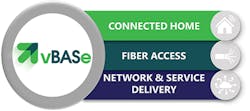Evolving the Access Network to Support Any Speed
“During 2020 and 2021, the world has stopped going mobile, and the position and relevance of wireline has been cemented." This was the message delivered by Analysys Mason (https://www.analysysmason.com/) alongside its report: Fixed Network Data Traffic: Worldwide Trends and Forecasts 2020-2026. Marking a significant shift in broadband traffic, the research found, for the first time, that traffic on fixed networks grew faster than on mobile in about half of all countries modelled. Worldwide, fixed network traffic grew by 42% in 2020—a substantially higher growth than forecast before the COVID-19 pandemic.
These changes reflect the adjustments that much of the world had to make when the pandemic hit. Working from home became the norm for many as offices across the globe shutdown to adhere to national lockdowns. The lockdowns also brought about an increase in OTT video subscriptions and service stacking—all of which are likely to continue. According to Analysys Mason, traffic growth was also strong in emerging countries where mobile networks alone cannot keep up with the rising demand in underserved areas.
While many mobile operators may argue the introduction of 5G nationwide rollouts buck this trend, what is most relevant is that whether you are using a mobile device or a WiFi-enabled device when in the home or the office, most developed countries depend on the fixed broadband network to transport this traffic. In usage and transport, 5G and fixed traffic will depend on the fiber access network. Progressively this will be a PON network.
Looking ahead, Analysys Mason predicts that while there might be a slower growth short-term as the effects of lockdowns wear off, the growth rates for fixed and mobile will ultimately converge, with fixed access growth overtaking that of mobile by 2025. As in years past, access networks and the operators who run them are tasked with coping with this enormous growth in traffic.
As we see these predictions come to the fore, and traffic growth continuing at exponential levels, what can we expect to see in terms of the technologies and developments that will meet this need? And how will access networks evolve to meet ever-changing requirements?
As PON technology has developed, demand for superfast fiber networks has grown alongside it. Government broadband targets, requirements for 5G backhaul, and increased use of the fixed network as a result of the COVID-19 pandemic, are all factors in this growth.
The result is a significant increase of rapidly growing PON deployments, most notably in the North America, EMEA, and Asia markets, in addition to the more mature Chinese market, according to Julie Kunstler, Senior Principal Analyst at Omdia (https://omdia.tech.informa.com/). Looking at these worldwide deployments, GPON continues to lead the way, covering a 70% shipment share—but this is set to change considerably as network capacity requirements continue to grow.
It’s uPON Us
One of the biggest shifts we will see is the greater role played by 10 Gigabit Symmetrical PON (XGS-PON) in the coming year. The rate of XGS-PON deployments is already increasing rapidly.
Initially, this was seen in new fiber rollouts where it only made business sense to deploy PON technologies that will meet broadband demands for the next 5-to-10 years. Additionally, XGS-PON is increasingly being deployed in existing brownfield environments to coexist alongside existing GPON services. This is especially true in high density urban areas where operators are facing increasing demand for gigabit+ business services across the shared fiber infrastructure. Service providers such as CityFibre in the UK, AT&T in the US, and Chorus in New Zealand, are all investing in XGS-PON.
Looking ahead, the high demand for business, mobile, and residential, PON bandwidth ultimately require deployments that exceed 10 Gbps. Multiple standards are either complete or in process to support this need, including:
- ITU-T G.9804, which in its initial version will support 50G down and 25G up over single wavelengths, and which has earmarked a 50G symmetric version for further study.
- IEEE 50G-EPON, which runs over 2 wavelengths of 25G each. In the short term, the 25GS-PON Multi-Source Agreement (MSA), which combines IEEE 25G Optics with the ITU XGS-PON layer, is expected to start mass shipments in 2022.
Both the ITU and the MSA technologies have their adherents, and service providers must make informed choices based on their own network deployment strategies.
Looking a little farther out, both the IEEE and the ITU are developing SuperPON technologies that support up to 160 Gigabits aggregate over 16 wavelengths. Clearly, there is no shortage of innovation or bandwidth looking forward in PON technologies.
Wireline/Wireless Convergence
Standards are also playing a key role in the evolution of 5G, which, in turn, is impacting the access network more than ever before. The advent of 5G is seen by many operators as a prime opportunity to converge their fixed and mobile networks. The benefits include a seamless, access-independent service experience, multi-access connectivity, and a streamlined set of network functions required to operate their network. This convergence also enables common technology, on-boarding, training, and services between fixed and mobile divisions, and common subscriber management, as well as the chance to extend the reach of core networks and service offerings.
To ensure the full benefits of the 5G ecosystem across wireless and wireline environments, key elements of the access network must be updated. The 5G-capable Residential Gateway (5G-RG) fully supports 5G Quality of Service (QoS) to the home, as well as 5G signaling protocols and capabilities.
On the network side, the Access Gateway Function (AGF) provides the interface between the wireline access network and the 5G core and supports both 5G-RGs and legacy Residential Gateways. Importantly, the AGF works with existing access nodes, providing a path to convergence that doesn’t require massive upgrades. The AGF and other interface functions provide options that allow operators multiple migration paths to WWC.
A key feature of WWC is the capacity to multiplex multiple sessions, each as a unique connection between the 5G-RG and AGF on top of the customer VLAN for the converged fixed and mobile core network. This allows service providers to assign a unique User Plane Function (UPF) to different sessions, meaning video traffic, business traffic, and community WiFi, can all be assigned appropriate QoS and policies, as well as different owners for charging and billing.
A second enabler is multi-access with Access Traffic Steering, Switching, Splitting (ATSSS), which provides enhanced reliability by leveraging existing network coverage; if one link goes down, there is seamless availability for connectivity, bandwidth aggregation, and policy-based forwarding.
Copper to the Rescue
While the future is increasingly dependent on PON networks, copper continues to play an important role in extending fiber into and across the home. Broadband Forum’s TR-419 specifies the different ways that copper loops or coax can extend fiber’s reach, both to single family homes and within multiple dwelling units (MDUs).
Today’s access technologies designed for transmission over copper, including MGfast (ITU-T G.9711) and G.hn (ITU-T G.996x series), can provide multi-gigabit services, for example in MDUs where fiber service to the basement is extended across the building’s existing wiring to each unit. These technologies make multi-gigabit broadband deployments faster and easier than a fiber-only solution could for a significant percentage of users.
Finally, the nature of the access network itself is changing significantly. Network transformation to virtualized architectures such as CloudCO, and the disaggregation and repartitioning of the network functions within, enables rapid and dynamic responses to usage patterns that can change throughout the day and as a result of special events. In particular, separation of the Control and User Plane implementations in functions across the network brings numerous advantages, including centralized control while simultaneously bringing the data-handling functions closer to the user, improving both performance and manageability at the same time.
Whatever the technology used, the key for coping with future anticipated traffic growth is to build an infrastructure that can support users’ needs well into the future. The fiber and copper access technology trends described earlier do just that, while supporting migration paths that give operators flexibility with planning their deployments.
At the same time, network transformation helps operators plan efficient, scalable and dynamically responsive networks going forward. Operators with fixed and mobile networks can offer their users a consistent set of features and seamless performance as they move between wired and wireless connections. Viewed together, the trends in access network technologies continue to support the needs of both operators and end users for the foreseeable future.
For more information, visit https://www.broadband-forum.org/, and follow us on Twitter: https://twitter.com/Broadband_Forum?s=20.

